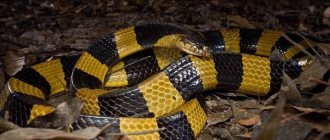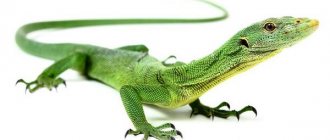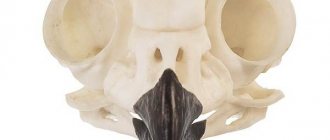Grasshoppers are insects that inhabit all continents of the planet except Antarctica. They live everywhere: in the mountains, on the plains, in forests, fields, cities and summer cottages. There is probably no person who has not seen a single grasshopper. Meanwhile, these insects are divided into 6,800 species, some of which vary greatly. Let's look at the most common and unusual ones.
What types of grasshoppers are there?
Green grasshopper
And this type is one of the simplest and most common. It can make traditional chirping noises and eats mixed food. When there is suitable prey nearby, the grasshopper is a predator. But if there is no one to catch and eat, it successfully feeds on plant foods: leaves, grass, buds of trees and shrubs, various grains, etc.
Green grasshoppers jump well and jump a short distance. Flight is possible only after a “starting” push with the hind legs.
Keeping at home
In some Asian countries, this insect is a popular pet, along with the cricket. Pleasant melodies are produced by male singing grasshoppers. Breeders from China have even been able to develop several varieties that sing differently from their wild ancestors. The cost of a particularly “euphonious” individual often reaches $25 .
Grasshoppers that live in mid-latitudes can also be kept indoors. Their food is ears of cereals, lettuce, pieces of fruit and berries. Small bugs and other living creatures are eaten at night, but if the individual is very hungry, hunting occurs at any time of the day.
When the time comes for females to lay eggs, they should be seated one at a time, otherwise the fight for territory can lead to cannibalism. And the males get along peacefully with each other and chatter until the fall.
Mormon Grasshopper
This species is classified as an insect pest, as it is capable of destroying plants specially planted by humans. Another difference between the “Mormon” is the size. Its length can reach 8 centimeters. It lives in North America, mostly in pastures, where it actively eats plant matter. This grasshopper often makes long migrations, covering a distance of up to two kilometers per day. However, he cannot fly.
The greenhouse grasshopper is a very miniature species.
These insects look more like arachnids. However, this does not prevent them from jumping over huge distances for their size, up to 50 cm. This species of “grasshopper” is named greenhouse due to their love of life in greenhouses and greenhouses. The body of representatives of this species is painted in shades of brown and gray, with characteristic spots. This insect can be found both on the territory of the Eurasian continent and on the American continents.
Amblycorifa
Grasshoppers can be more than just green. This is clearly demonstrated by the grasshopper - amblycorifa. Representatives of this species can be dark brown, pink and even orange! There is also a traditional green color. Interestingly, the color of a particular grasshopper is determined without any pattern. This is not affected by either the habitat or the color of the parents. However, dark brown and orange colors are very rare.
Hueta is gigantic.
The largest representative in the grasshopper family. These grasshoppers are real heavyweights. Their body weight can reach 70 grams. This species has powerful hind legs that serve more as a means of protection than movement. Their impressive body weight prevents them from jumping. Despite this, outwardly these insects have all the characteristic features of “grasshoppers” and cannot be confused with any other arthropod. They prefer to settle closer to populated areas; they live in caves, forests, and fields on the New Zealand island of Little Barrier.
Peacock grasshopper
This grasshopper received this name because of the pattern on its wings. When raised, they actually vaguely resemble a peacock's tail. The grasshopper uses its bright colors and unusual decoration on its wings as a psychological weapon. If there is danger nearby, the wings rise vertically, imitating the large size of the insect and huge “eyes”.
Lifestyle and reproduction
The natural green color helps the insect hide among plants. Large individuals can often be seen in meadows, fields, home gardens, and in desert areas - on the edges of floodplain gallery forests and in river valleys. In Asia, insects mainly live in the highlands, hiding in gorges overgrown with grass.
Both the adult insect and the larva have a green coloring, and small black inclusions can often be seen on its body. The lifestyle is solitary. These creatures do not have a permanent place of residence - they are found in trees, bushes or grass, and on hot days they wait among the greenery, leaving their shelter only early in the morning.
Insects mate for about one hour, the female eats the spermatophore for about 16 hours. Males chirp again within a few minutes after copulation. The larvae are laid at the end of summer - the female gives birth to more than 100 eggs. They have a cylindrical shape, their size is up to 7 mm. With the arrival of the first frosts, the adults die, and the larvae spend the winter - later, with the onset of spring, offspring appear.
The grasshopper feeds on butterflies, caterpillars and a number of other small mammals. Cases of cannibalism have been reported .
If there are some difficulties with food, insects can eat flowers, plants, cereals, and leaves. There are frequent cases of attacks on vineyard thickets.
Ball-headed grasshopper
This species received this name for the spherical shape of its head. In fact, this species includes several varieties of grasshoppers, for example, the steppe fatty. It is distinguished by its black-bronze color and small distribution. In our country, the steppe plum lives in the Krasnodar and Stavropol territories, Chechnya, and North Ossetia. Listed in the Red Book.
Steppe rack.
A fairly large variety of grasshoppers. The body size reaches 80 mm. This insect has small, underdeveloped wings, in some cases there are no wings at all. The rack is painted in shades of green and lemon. This allows it to camouflage perfectly in the vegetation of steppes and ravines. Unfortunately, the population of this species is constantly declining, and one day it will disappear from the face of the earth.
Where is the grasshopper's ear?
The complex hearing apparatus, that is, the grasshopper's ears, is located on the shins of the insect's front legs. Thus, we can say that the grasshopper hears with its feet. The oval membranes that are located on both sides of the lower leg act as eardrums. In some species of grasshoppers, the membranes are open, in others they are closed with special caps. The structure of the hearing aid consists of nerve endings, muscles, and sensory cells. The structure also includes 2 branches of the trachea, which approach the eardrums.
Grasshoppers have noticeable sexual dimorphism: females are much larger than males and have a sickle-shaped or straight, arrow-like ovipositor. The lifespan of a grasshopper, including the egg stage, is only one season.
Appearance and features
Photo: What a grasshopper looks like
Grasshoppers are medium to large insects. The length of an adult varies from 1 to 7 centimeters, depending on the species. Like their relatives the katydids and crickets, grasshoppers have chewing mouths, two pairs of wings, one narrow and stiff, the other wide and flexible, and long hind legs for jumping. They differ from these groups in that they have short antennae that do not extend too far back to their bodies.
The femoral region of the upper hind limbs of the grasshopper is significantly enlarged and contains large muscles that make the legs well adapted for jumping. The male may produce a buzzing sound by either rubbing the forewings (Tettigoniidae) or rubbing tooth-like projections on the hind femurs against a raised vein on each closed forewing (Acrididae).
Interesting fact: The grasshopper is an amazing insect that can leap 20 times its body length. The grasshopper doesn't actually "jump". He uses his paws as a catapult. Grasshoppers can jump and fly, they are capable of reaching speeds of 13 km/h when flying.
Grasshoppers typically have large eyes and are colored accordingly to blend in with their surroundings, usually a combination of brown, gray or green. Some species of males have bright colors on their wings, which they use to attract females. Several species feed on toxic plants and store the toxins in their bodies for protection. They are brightly colored to warn predators that they taste bad.
Female grasshoppers are larger than males and have sharp points on the end of their abdomens that help them lay eggs underground. The grasshopper's senses contact organs located in various parts of its body, including the antennae and palps on the head, the cerci on the abdomen, and the receptors on the legs. The organs of taste are located in the mouth, and the organs of smell are located on the antennae. The grasshopper hears using a tympanic cavity located either at the base of the abdomen (Acrididae) or at the base of each fore tibia (Tettigoniidae). His vision is carried out in the compound eyes, while changes in light intensity are perceived by the simple eyes.
Adaptation of grasshoppers to their environment
Many animals feed on grasshoppers, and they face death every second. Therefore, they fight for life, using all the opportunities given by nature. The main methods of defense of grasshoppers are protective and dismembering coloration, the ability to hide, jumping legs, spines with which they signal to relatives about approaching danger, and the ability to bite. For example, the leaf grasshopper from Sudan can bite through human skin until it bleeds. But there are also lesser-known types of protection for these insects.
When threatened, some grasshoppers can tear off their legs. The ability of animals to break off body parts is called autotomy. Grasshoppers easily lose one of their hind legs, and sometimes both. Close to the phenomenon of autotomy is the process of self-mutilation - gnawing off limbs in response to irritation. This is especially common in some grasshoppers.
Protective coloring seems to be a simple and primitive way of protection. Grasshoppers also use other, more complex methods of deception. Mimicking leaves is a favorite technique used by many insects. One of the grasshoppers of the species Cycloptera elegans looks very much like a dried leaf. The similarity is enhanced by spots on its wings, reminiscent of a fungal infection of the leaves.
Another grasshopper from the genus Pterochosa, living in America, is similar in color, pattern, and arrangement of veins to a withering and discarded leaf. There are spots on its wings that resemble damage to leaves by leaf miners. This ideal method of copying was called “hyperthemia” (overimitation).
Other species imitate the resemblance to a twig protruding from a trunk, lichen growths on tree trunks. There are grasshoppers that can scare away attackers with a squeal and cause disgust with a drop of regurgitated gastric juice.
Photo credit: gailhampshire, CC BY 2.0
Grasshoppers as a food product
Grasshoppers are a common food product in many countries around the world. They contain a lot of protein and other nutrients. For Europeans, eating insects is something repulsive and disgusting. However, many peoples of Asia and Africa enjoy this tasty and healthy food.
Grasshopper dishes:
- fried dry insects taste like peanuts,
- grasshoppers fried in oil with garlic,
- grasshopper fritters,
- marinated grasshoppers baked on skewers,
- deep-fried grasshoppers.
In order to catch a sufficient number of insects, it is enough to go out onto the green lawn with a net. The energy value of a grasshopper is about 150 kilocalories per 100 grams of product. The average protein content is higher than in meat and is 25 grams.
In the near future, grasshoppers, locusts, crickets and worms may well become a familiar and widespread product. Already, some manufacturers are adding insect flour to their products, thereby increasing their nutritional value.
Devil's spiny grasshopper / Panacanthus cuspidatus
This insect with a terrifying name and appearance reaches a length of 60–70 mm.
The grasshopper's body is bright green, and each limb is covered with sharp, most often yellow, spines. In case of danger, the spiny devil rises sharply to its hind limbs, pushing its forelimbs forward. He swings them until the enemy retreats.
Despite its hostility towards enemies, it is quite peaceful and calm, feeding mainly on the seeds of flowering plants.
5
The chirping of a grasshopper. What does a grasshopper chirp with?
If we talk about what the grasshopper chirps and what sound it makes, then this moment is very interesting. On the left elytra of the grasshopper there is a membrane with a thick stridulatory vein, which has denticles - it plays the role of a bow. And on the right elytra there is a membrane that plays the role of a resonator. When chirping, the grasshopper vibrates its elytra, raising them.
Each species of grasshopper produces sounds that are unique in melody and volume. The ability to chirp is endowed mainly with the male grasshopper and only a few species of females. Other individuals are wingless or have very poorly developed wings, so they cannot chirp or make other sounds.
The color of grasshoppers in nature depends on their habitat, is an excellent camouflage and can combine different shades of the same color (for example, green), as well as bright spots or spectacular stripes.
By the way, you can read about the difference between locusts and grasshoppers in the article about locusts.
Origin of the species and description
Modern grasshoppers are descended from ancient ancestors that lived long before dinosaurs roamed the Earth. Fossil evidence shows that primitive grasshoppers first appeared during the Carboniferous period, more than 300 million years ago. Most ancient grasshoppers are preserved as fossils, although grasshopper larvae (the second stage in a grasshopper's life after the initial egg phase) are sometimes found in amber. Grasshoppers are divided according to the length of their antennae (tentacles), which are also called horns.
Fat Pallas
The dimensions of this species are 5 cm in females and 6 cm in males. A unique feature of the fat man is that in the process of evolution he completely forgot how to jump.
This makes it defenseless against predators and people who tirelessly conquer the insect’s habitat by plowing the land and grazing livestock.
The colors of these grasshoppers are varied, but variegated individuals are more common. They feed mainly on plant foods; in times of acute shortage, they can also devour their fellow creatures.











